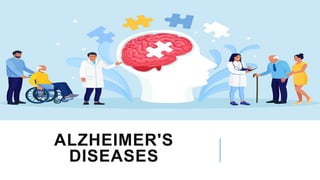
Alzhiemer’s diseases.pptx
- 2. The Impact of AD Once considered a rare disorder, Alzheimer’s disease is now seen as a major public health problem that is seriously affecting millions of older Americans and their families 10/24/2023 2
- 3. WHAT IS ALZHEIMER’S DISEASE Alzheimer’s disease is an irreversible, progressive brain disease that slowly destroys memory and thinking skills. 10/24/2023 3
- 4. •AD is the most common cause of dementia among people age 65 and older. •Current estimates (2017) suggest that 44 million people live with dementia worldwide at present •In England and Wales, dementia is the leading cause of death overall, accounting for 11.6% of all deaths registered in 2015 •AD is the single biggest cause of dementia, accounting for 50%– 75%, and is primarily a condition of later life, roughly doubling in prevalence every 5 years after age 65 10/24/2023 4
- 5. • For every 5-year age group beyond 65, the percentage of people with AD doubles. •By 2050, 13.2 million older Americans are expected to have AD if the current numbers hold and no preventive treatments become available. Where are people with AD cared for? •home •assisted living facilities (those in the early stages) •nursing homes (special care units) 10/24/2023 5
- 6. THE THREE MAIN PLAYERS •Cerebral hemispheres •Cerebellum •Brain stem 10/24/2023 6
- 7. THE BRAIN ACTION HEARING WORDS SPEAKING WORDS SEEING WORDS THINKING ABOUT WORDS 10/24/2023 7
- 8. AD AND THE BRAIN Plaques and Tangles: The Hallmarks of AD The brains of people with AD have an abundance of two abnormal structures: •Beta-amyloid plaques, which are dense deposits of protein and cellular material that accumulate outside and around nerve cells •Neurofibrillary tangles, which are twisted fibers that build up inside the nerve cell 10/24/2023 8
- 9. BETA-AMYLOID PLAQUES Amyloid precursor protein (APP) is the precursor to amyloid plaque. 1. APP sticks through the neuron membrane. 2. Enzymes cut the APP into fragments of protein, including beta-amyloid. 3. Beta-amyloid fragments come together in clumps to form plaques In AD, many of these clumps form, disrupting the work of neurons. This affects the hippocampus and other areas of the cerebral cortex 10/24/2023 9
- 10. PET SCAN OF NORMAL AND AD BRAIN 10/24/2023 10
- 11. Preclinical AD: • Signs of AD - entorhinal cortex, then proceed to the hippocampus. • Affected regions begin to shrink as nerve cells die. • Changes can begin 10-20 years before symptoms appear • Memory loss is the first sign of AD. •Mild AD signs can include memory loss, confusion, trouble handling money, poor judgment, mood changes, and increased anxiety. •Moderate AD signs can include increased memory loss and confusion, problems recognizing people, difficulty with language and thoughts, restlessness, agitation, wandering, and repetitive statements. Severe AD • extreme shrinkage occurs in the brain. • Symptoms can include weight loss, seizures, skin infections, groaning, moaning, or grunting, increased sleeping, loss of bladder and bowel control. • Death usually occurs from aspiration pneumonia or other infections. 10/24/2023 11
- 12. AD AND THE EYE • Alzheimer's disease is caused by an abnormal build-up of proteins in the brain that kills cells and damages connections between neurons. •Symptoms can also include vision problems, especially trouble with spatial relationships and depth perception •Some patients develop trouble reading, following moving objects, or have problems with contrast •Some people get mild cognitive impairment (MCI) in older age, which may or may not get worse with time •Right now, Alzheimer's disease is diagnosed after a series of assessments and exams that rule out other things. 10/24/2023 12
- 13. • A recent study showed that people who have macular degeneration, glaucoma or diabetic retinopathy are more likely to be diagnosed with Alzheimer's disease than people without these conditions •There is no cure for Alzheimer's disease, but some medicines and lifestyle interventions may help people with the disease function well for longer. 10/24/2023 13
- 14. Ocular Structures Pathological Changes in AD Retina - Deposition of proteins tau, Aβ and pTAu. Impaired metabolism of amyloid β precursor protein (APP) - Reduction in retinal ganglion cells -Reduction of retinal thickness -Reduction in the retinal nerve fiber layer thickness (RNFL) -Retrograde degeneration secondary to loss of cortical neurons - Inflammation Retinal and choroidal vasculature -Retinal and choroidal vascular β-amyloid deposits in transgenic mouse model of AD lead to retinal degeneration - Impaired vascularization Retinal vascular blood flow - Blood flow disturbances can lead to neurodegeneration Optic nerve -Axonal degeneration in the axonal segments -Loss of optic nerve thickness -Papillary paleness due to axonal loss and perfusion alterations Lens -Correlation between AD and supranuclear cataract - Presence of abnormal protein deposits 10/24/2023 14
- 15. Visual Function Pathological Changes in AD Visual fields - Inferior hemi field loss Visual acuity - Decreased visual acuity in low luminance Sensory perception - Clinically important symptoms of visuospatial disorientation Visual processing - Deficits of visual motion perception Contrast sensitivity - Contrast sensitivity disturbances and motion perception Color vision - Color discrimination error inversely proportional with mini-mental state examination (MMSE) score Stereopsis - Reduced stereoscopic depth perception Circadian rhythm - Alterations in the circadian rhythm 10/24/2023 HTTPS://EYEWIKI.AAO.ORG/OCULAR_MANIFESTATIONS_OF_ALZHEIMER_DISEASE 15 Tears - Changes in the chemical barrier composition of tears Cornea - Reduced corneal sensitivity Pupil - Pupillary response, possible biomarker Choroid - Attenuation of choroidal thickness
- 16. 10/24/2023 16
- 17. 10/24/2023 17
Editor's Notes
- Although the risk of developing AD increases with age – in most people with AD, symptoms first appear after age 60 – AD is not a part of normal aging. It is caused by a fatal disease that affects the brain.
- Different mental activities take place in different parts of the brain. Positron emission tomography (PET) scans can measure this activity. Chemicals tagged with a tracer “light up” activated regions shown in red and yellow